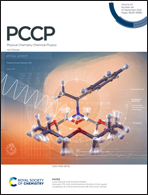Benchmarking dispersion-corrected DFT methods for the evaluation of materials with anisotropic properties: structural, electronic, dielectric, optical and vibrational analysis of calcite (CaCO3, space group R![[3 with combining macron]](https://www.rsc.org/images/entities/char_0033_0304.gif) c)†
c)†
Abstract
Calcite (CaCO3, space group R![[3 with combining macron]](https://www.rsc.org/images/entities/char_0033_0304.gif) c) is a solid phase whose well-known highly anisotropic physical properties can be exploited to compare and calibrate various theoretical simulation methods. In this work, to benchmark different ab initio Density Functional Theory approaches that include for the first time corrections for dispersive forces, a systematic analysis of structural, electronic, dielectric, optical and vibrational properties of calcite is performed. The simulations considered the generalized-gradient approximation functional PBE and the hybrid B3LYP and PBE0, whereas the DFT-D2 and DFT-D3 schemes were adopted to account for the long-range interactions. This study suggests an overall better agreement between the theoretical results obtained with the DFT functionals corrected for the dispersive forces, with a better performance of hybrid functionals over PBE.
c) is a solid phase whose well-known highly anisotropic physical properties can be exploited to compare and calibrate various theoretical simulation methods. In this work, to benchmark different ab initio Density Functional Theory approaches that include for the first time corrections for dispersive forces, a systematic analysis of structural, electronic, dielectric, optical and vibrational properties of calcite is performed. The simulations considered the generalized-gradient approximation functional PBE and the hybrid B3LYP and PBE0, whereas the DFT-D2 and DFT-D3 schemes were adopted to account for the long-range interactions. This study suggests an overall better agreement between the theoretical results obtained with the DFT functionals corrected for the dispersive forces, with a better performance of hybrid functionals over PBE.
![Graphical abstract: Benchmarking dispersion-corrected DFT methods for the evaluation of materials with anisotropic properties: structural, electronic, dielectric, optical and vibrational analysis of calcite (CaCO3, space group R [[3 with combining macron]] c)](/en/Image/Get?imageInfo.ImageType=GA&imageInfo.ImageIdentifier.ManuscriptID=D1CP02673A&imageInfo.ImageIdentifier.Year=2021)


 Please wait while we load your content...
Please wait while we load your content...
![[3 with combining macron]](https://www.rsc.org/images/entities/h2_char_0033_0304.gif) c)
c)